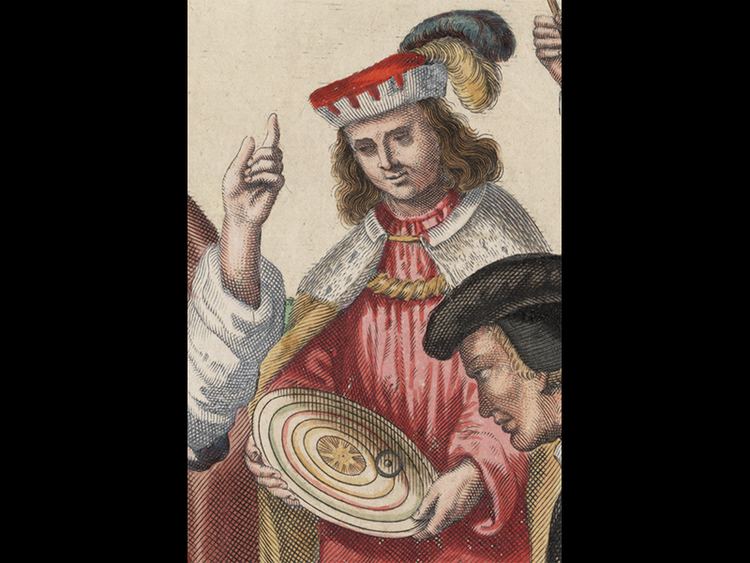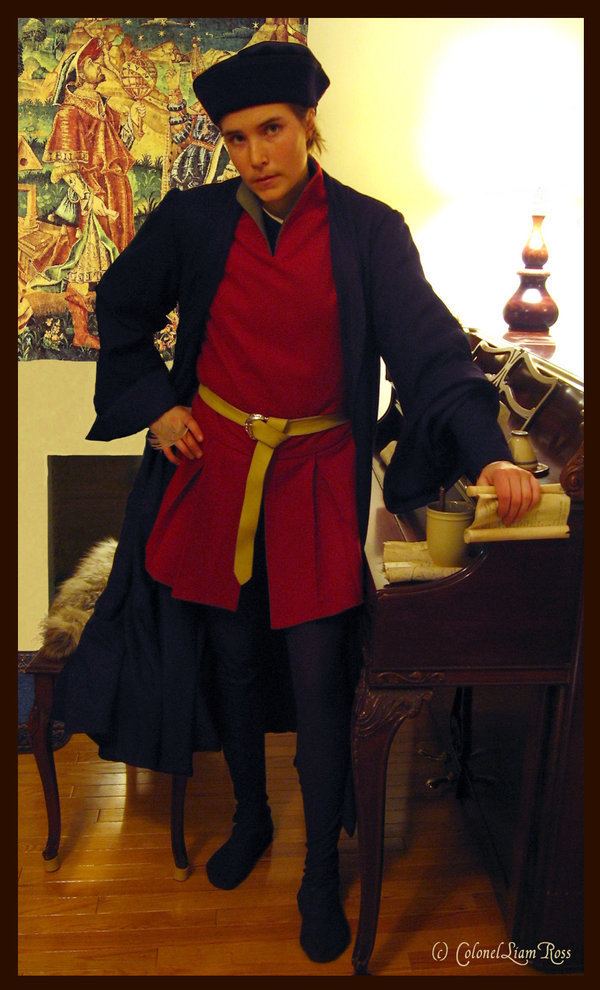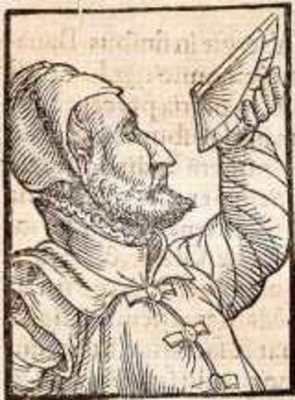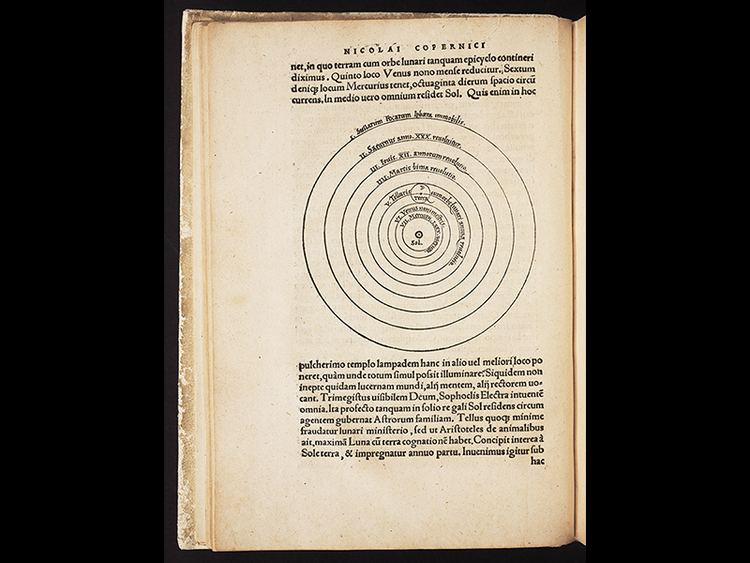Name Georg Rheticus Academic advisor Conrad Gessner | Role Mathematician | |
 | ||
Full name Georg Joachim de Porris Born 16 February 1514Feldkirch, Waldburg-Sonnenburg (in present-day Austria) ( 1514-02-16 ) Alma mater University of Wittenberg Academic advisors Conrad GesnerOswald MyconiusNicolaus Copernicus Education Charles University in Prague, University of Zurich, Martin Luther University of Halle-Wittenberg Similar People Andreas Osiander, Nicolaus Copernicus, Caspar Peucer, Conrad Gessner, Gerolamo Cardano | ||
Georg joachim rheticus
Georg Joachim de Porris, also known as Rheticus (16 February 1514 – 4 December 1574), was a mathematician, cartographer, navigational-instrument maker, medical practitioner, and teacher. He is perhaps best known for his trigonometric tables and as Nicolaus Copernicus's sole pupil. He facilitated the publication of his master's De revolutionibus orbium coelestium (On the Revolutions of the Heavenly Spheres).
Contents
- Georg joachim rheticus
- Surname
- Patrons
- Copernicus
- Criminal history
- Later years
- Trigonometry
- In popular culture
- Works
- References

Surname

Rheticus was born at Feldkirch, in present-day Austria. Both his parents, Georg Iserin and Thomasina de Porris, possessed considerable wealth, his father being the town physician. However, Georg (Iserin) abused the trust of many of his patients, stealing belongings and money from their homes. In 1528 he was convicted and executed for his crimes, and as a result his family was stripped of their surname.

The family adopted the mother's maiden name: de Porris. Later as a student in Wittenberg, Georg Joachim adopted the toponym Rheticus, a form of the Latin name for his home region, Rhaetia, a Roman province that had included parts of Austria, Switzerland and Germany. In the matriculation list for the University of Leipzig his family name, de Porris, is translated into German as von Lauchen. The lunar crater Rhaeticus is named for him.
Patrons

After Georg Iserin's death, Achilles Gasser took over his medical practice, helping Rheticus to continue his studies and supporting him. Rheticus studied at Feldkirch, Zürich and the University of Wittenberg, where he received his M.A. in 1536.

During the Reformation the theologian and educator Philipp Melanchthon reorganized the whole educational system of the Lutheran Protestant parts of Germany, reforming and founding several new universities. In 1536 Melanchthon appointed Rheticus as professor of the lower mathematics, arithmetic and geometry, at the Wittenberg University.

Two years later, Melanchthon arranged a two-year leave for Rheticus to study with noted astronomers. Leaving Wittenberg in October 1538, he first went to Nuremberg to visit the professor of mathematics at the Eigidien Oberschule Johannes Schöner. In Nuremberg he also made the acquaintance of other mathematicians such as Georg Hartmann and Thomas Venatorius as well as the printer-publisher Petreius. During his journey, probably in Nuremberg, Rheticus heard of Copernicus and decided to seek him out. From Petreius Rheticus was given works by Regiomontanus and others, intended as presents for Copernicus. He went on to Peter Apian in Ingolstadt and Joachim Camerarius in Tübingen, then to Gasser in his hometown. From Feldkirch he set out on his journey to visit Copernicus in Frombork.
Copernicus

In May 1539, Rheticus arrived in Frombork (Frauenburg), where he spent two years with Copernicus. It is unknown whether he had prior access to Copernicus' Commentariolus, an unsigned, unpublished outline of Copernicus' revolutionary heliocentric theory that Copernicus distributed to friends and colleagues three decades before he published De revolutionibus.
In September 1539, Rheticus went to Danzig (Gdańsk) to visit the mayor, who gave him financial assistance to publish his Narratio Prima (First Report) of Copernicus' forthcoming treatise. Rhode in Danzig published Narratio Prima in 1540. While in Danzig, Rheticus interviewed maritime pilots to learn about their problems in navigation. Rheticus also visited Copernicus' friend, Tiedemann Giese, who was Bishop of Culm (now Chełmno).
In August 1541, Rheticus presented a copy of his Tabula chorographica auff Preussen und etliche umbliegende lender (Map of Prussia and Neighboring Lands) to Albert, Duke of Prussia, who had been trying to compute the exact time of sunrise. Rheticus made an instrument for him that determined the length of the day. Rheticus obtained the duke's permission to publish De revolutionibus. Albrecht asked Rheticus to end his travels and return to his teaching position. Rheticus returned to the University of Wittenberg in October 1541. In May 1542, he traveled to Nürnberg to supervise the printing by Johannes Petreius of the first edition of De revolutionibus, but had to leave in fall to take a position in Leipzig, and Andreas Osiander replaced him. Copernicus' major work was published shortly before his death in 1543.
In a work tentatively titled Epistolae de Terrae Motu, published posthumously and anonymously in 1651, Rheticus attempts to reconcile Copernicanism with scripture by employing St. Augustine's principle of accommodation. According to historian Robert Westman, the Epistolae, also known as the Opusculum, demonstrates that Copernicus and Rheticus recognized the problem of conflict between their finding of earthly motion and biblical scripture, and had therefore developed a systematic defense of compatibility. Rheticus argues that biblical language was written in terms meant to be readily comprehensible to a wide audience:
It borrows a kind of discourse, a habit of speech, and a method of teaching from popular usage.
While relying heavily upon citations to appease religious authorities, Rheticus may have nevertheless refrained from publishing the work in his life in order to avoid angering more conservative Christians such as Melanchthon.
Criminal history
In 1552, Rheticus was found guilty of raping the son of Hans Meusel, a merchant. According to Meusel, Rheticus "plied him with a strong drink, until he was inebriated; and finally did with violence overcome him and practice upon him the shameful and cruel vice of sodomy". Rheticus was consequently exiled from Leipzig for 101 years.
Later years
The canon of Warmia Georg Donner and the bishop of Warmia Johannes Dantiscus were both patrons of Rheticus. Rheticus was also commissioned to make a staff for king Sigismund II of Poland, while he held a position as teacher in Kraków for many years. From there he went to Košice in the Kingdom of Hungary, where he died.
Trigonometry
For much of his life, Rheticus displayed a passion for the study of triangles, the branch of mathematics now called trigonometry. In 1542 he had the trigonometric sections of Copernicus' De revolutionibis published separately under the title De lateribus et angulis triangulorum (On the Sides and Angles of Triangles). In 1551 Rheticus produced a tract titled Canon of the Science of Triangles, the first publication of six-function trigonometric tables (although the word trigonometry was not yet coined). This pamphlet was to be an introduction to Rheticus' greatest work, a full set of tables to be used in angular astronomical measurements.
At his death, the Science of Triangles was still unfinished. However, paralleling his own relationship with Copernicus, Rheticus had acquired a student who devoted himself to completing his teacher's work. Valentinus Otho oversaw the hand computation of approximately 100,000 ratios to at least ten decimal places. When completed in 1596, the volume, Opus palatinum de triangulis, filled nearly 1,500 pages. Its tables were accurate enough to be used in astronomical computation into the early twentieth century.
In popular culture
Rheticus narrates the third part of John Banville's 1975 novel Doctor Copernicus, relating how he convinced Copernicus to publish the book. The novel itself is less about Copernicus's work than about his life and the 16th century world in which he lived.
The episode "Claudia" of the U.S. science fiction series Warehouse 13 referencing a teleportation device in the form of a compass said to have been built by Rheticus.
Rheticus is referenced several times in the song "Like Rheticus" on the 2004 album Place by British songwriter Owen Tromans.
Dava Sobel's 2011 book, A More Perfect Heaven: How Copernicus Revolutionized the Cosmos, features a fictional play about Rheticus' visit to Copernicus, sandwiched between chapters about the visit's pre-history and post-history.
